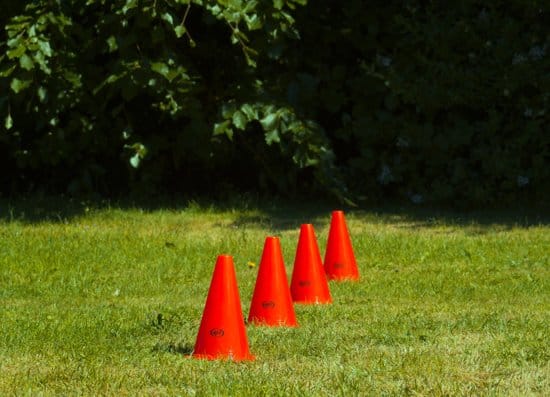I enjoy writing these articles for my readers, you guys. I don't accept payment for writing reviews, my opinion on products is my own, but if you find my recommendations helpful and you end up buying something through one of the links I may be able to receive a commission on that. More information
In this post I want to help you choose the right soccer goal for the age and skill level of your child or your pupils.
I'll take you through the different options and the pros and cons of each so you can make the right choice.
Whether it's a cheap goal you want to buy, or a goal that they can really practice with, everyone plays at a certain level and there are quite a few options to choose from.

Let's look at the different options you have when buying a football goal.
In short, you can of course have a large Doel buy aluminum that you can put up near you, You already have this one from EXIT Maestro for a good price and will be sufficient for most home situations to kick a nice ball.
Let's take a quick look at all the options I found during my research, then I'll dig deeper with a review of each of them:
| Football goal | Images |
|---|---|
| Best sturdy pop up soccer goals set: EXIT pico | 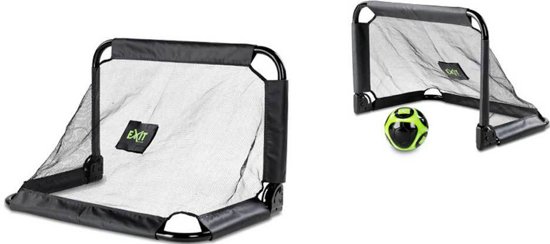
|
| Best goal for the garden: EXIT Master | 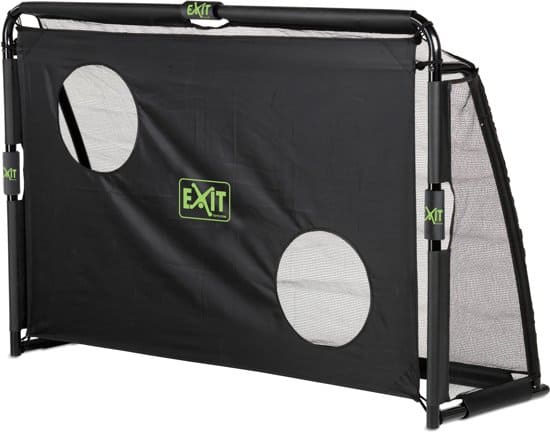
|
| Best Collapsible Soccer Goal: EXIT Coppa | 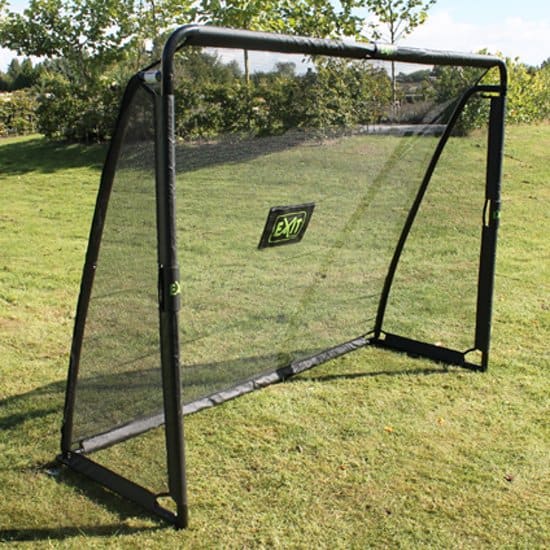
|
| Best aluminum soccer goal: EXIT Range | 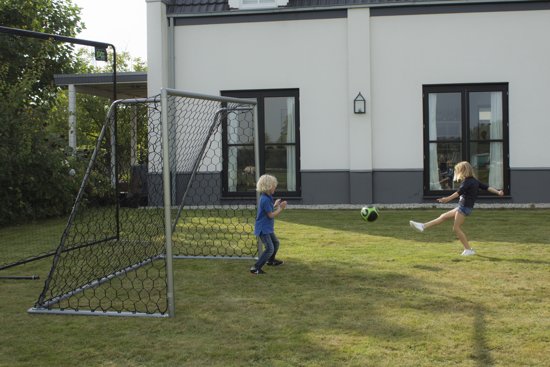
|
| Best cheap kids soccer goals: Dunlop Mini | 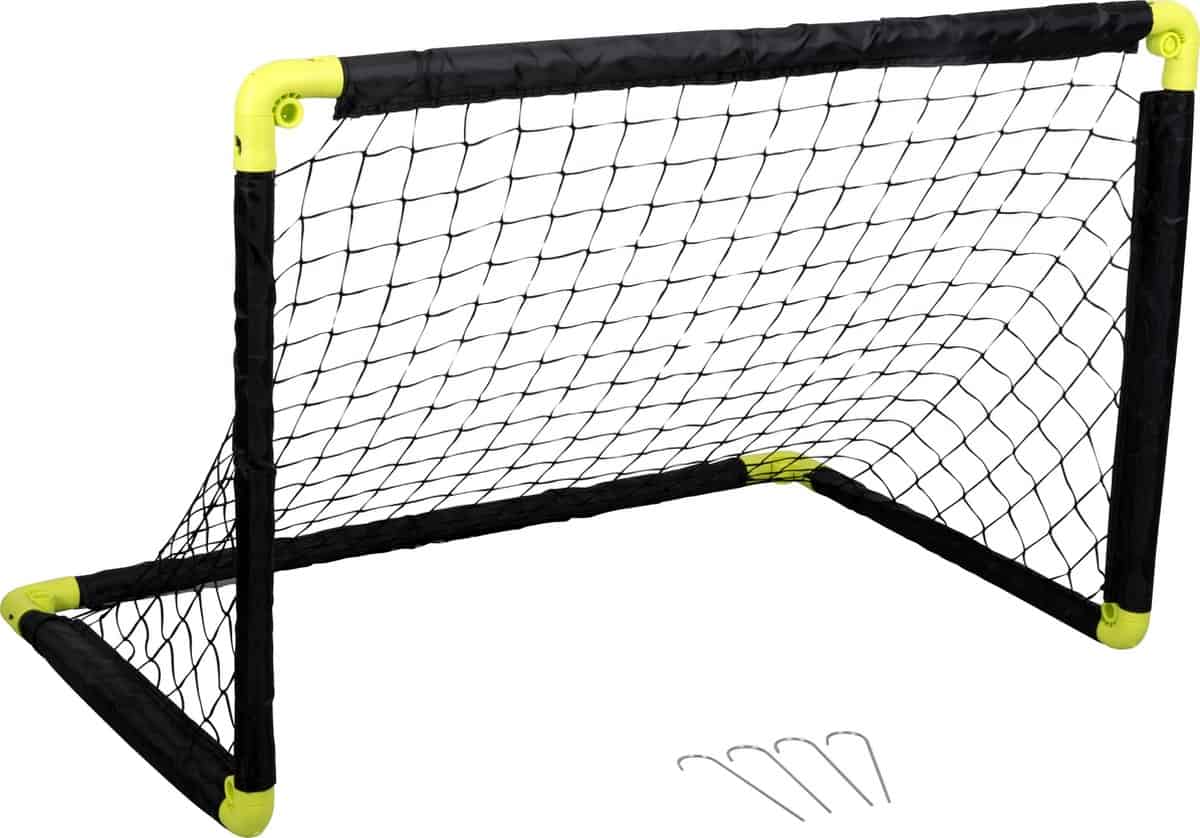
|
What we discuss in this comprehensive post:
Football goal buyer's guide: this is how you choose your goal
We've already given you some options in the different age categories, but it's still a choice that you might not know how to make.
Regardless of age, you can also choose the right type of goal for a certain style of play:
- At home in the garden or with you to the park, small pop-up goals or a slightly larger frame are very suitable, such as the EXIT Pico's or perhaps also the Maestro
- A target for small training sessions: For 4 or 5-on-1 sessions, with goalkeepers optional, the recommended target size is 4' x 6' - the football goals are small enough to reward accuracy over just shooting hard. For example, the EXIT Maestro is very suitable for this
- Medium training sessions: For 7 vs 7 games on a field of approximately 42,5 by 30 meters, go for 2 meters high and 3 to 4 meters wide, like the EXIT Coppa
- Practicing precision shots: For sessions where you really want to focus on passing and moving, a pair of EXIT Pop-up targets are perfect or the Maestro with a training screen with precision holes in it
Here are a few more tips to keep in mind when choosing the right soccer goal.
Which materials are best for goals?
Football goals come in a wide variety of sizes, shapes and options, designed for everyone from the smallest athlete, in his backyard with dad, to the most precise, professional World Cup team in the world.
In general, football goals are made of two materials, plastic or metal (usually aluminum), which determine the price, purpose and performance of the goal.
You can certainly base your choice on the material of the target and how much you want to spend. In general, more expensive materials are more durable and the goal will therefore last longer, and often give a "more real" feeling.
Plastic soccer goals
Advantages of plastic soccer goals:
- Affordable
- Light weight
- Very portable
- Easy to place on field or grass with anchors
- Can be adjustable, foldable, collapsible and storeable
Designed for youth players, simple training and recreational play.
Disadvantages of plastic soccer goals:
- Less durability and weight than metal
- Makes them best suited for low-impact, low-use play
Metal Soccer Goals
Advantages of metal soccer goals:
- High-quality design for serious play
- More durable than plastic
- High performance and durability
- Designed for permanent or semi-permanent installation
Great for high impact play and ideal for football clubs, leagues, schools, tournaments, etc. Widely available in a variety of sizes and styles.
Disadvantages of metal soccer goals:
- More expensive to purchase
- Heavier to carry
- Not always collapsible for storage
What are the differences between goals with and without depth?
Football goals are designed differently, for different ages, players and leagues. Some goals are simple, while others are designed more complexly.
It is important to understand the different styles of soccer goals, to know which one is right for your player, your league and your budget.
Goals without depth
- Simply designed soccer goals with a single top crossbar
- Net hangs up and connects to the side and rear bars, creating a 45 degree angle with the ground
- Typically lighter and more portable
- Provides no space for the keeper to defend himself within the goal itself
- Limits the space within the target
Football goal with depth
- More complex designs with a single top bar and two bars angled 90 degrees to the front bars, extending a few feet further into the net
- Bars and net fall at a 45 degree angle to the back of the net
- Creates more space in the net to prevent players from getting confused and improve goalkeeper performance
- Manufactured with a heavier and higher quality metal or plastic
- Can be permanent or portable
- Found in youth or high school leagues
Box Goals
- Large, rectangular shaped soccer goals designed with a box frame of all 90 degree angles
- Net runs over the frame and provides the most space in the goal
- Usually used for professional or high-level football clubs
- Generally heavy metal targets, available in permanent or portable options
Should I buy a portable or permanent football goal?
It all depends on what kind of goal you need, your budget and your leeway.
Portable football goals are:
- lighter,
- can be folded
- and are quite easy to move around for storage.
- They are ideal for practice, training and even playing on public fields, where permanent goals cannot be installed.
- Portable targets are temporarily installed with simple anchors, which can be removed when the game is over.
- They come in all sizes, designs and prices, from affordable and basic training rebounders for youth players to more expensive, full-size tournament-style targets.
- Typically, portable targets are less expensive than their permanent installation counterparts, primarily due to their lighter weight.
Permanent, semi-permanent or in-ground football goals are:
- one of the heavier and more expensive football goals on the market.
- They are also the most durable, reliable, stable, secure and high performing goals out there.
- That's because, with robust aluminum frames and anchors and foundations anchored to the ground, these goals can be used extensively and remain stable during even the most intense play.
- Due to their cost and space requirements, permanent or in-ground installation football goals are ideal for football clubs, schools, professional teams, stadiums and year-round football fields, offering plenty of space and a dedicated or year-round football league or team.
Are pop-up soccer goals a good option for me?
Pop-up soccer goals are some of the coolest, most versatile soccer goals on the market!
Made from a lightweight, pliable, yet sturdy frame, with a nylon cover, they fold into a flat circle for easy storage and transport, and when you're ready to play, they just pop back into shape!
The pop-up goals are easy to set up in the park or backyard, complete with a fine net and anchor pegs for instant safe play.
Because of their size, versatility and affordability, pop-up soccer goals are perfect for:
- Recreational football training, playing field or backyard
- Personal exercise at home or on the sidelines
- Youth and developing players
How big should football goals be officially?
Kids Training Goals
After careful research, the KNVB adjusted the dimensions of football fields and goals in 2017. They found that kids didn't enjoy it because they thought their field was too big with big goal posts at each end.
The under 6s play 20v15 on a 3x1m pitch with 7x30m goals while the 20 year olds play 3v1 on a XNUMXxXNUMXm pitch with XNUMXxXNUMXm goals at either end, perfect for enjoying the game on their own or as a team. football!
The under 8, 9 and 10 pupils play six against six on a 42,5×30 m field with 5×2 m goals. The under 11 and 12 players have the same sized goals but an expansive 64×42,5 meter field, which is perfect for aspiring football fans who have not yet reached puberty, and for those just starting out in competition or playing professionally!
How big is a professional football goal for a full field?
Football clubs must comply with the standards and regulations set by the KNVB. The pitch must be 105x69m or 105x68 international dimensions, while the goals are 7,32mx 2,44m and these goals are also the standard for 11 v 11 training sessions and matches for U14 players and over.
Best soccer goals rated
Best sturdy pop up soccer goals set: EXIT Pico

For players aged 6 and 7, the goal should be 1.2 meters high and 1.8 meters wide.
It is of course not an obligation to buy a goal of that size yourself, but it is good to know what they are likely to come into contact with on the field.
Weighing 3,5' x 6', the lightweight structure makes it easy to carry - when folded into the carry bag, EXIT's football goals are only 2" flat.
Pop-up soccer goals can be used for training sessions with any number of players on each side and on any surface.
Teams will also need to show good moves and quick passes when using these nets, as they need to get close to the goal to have a chance of scoring.
Children of this age play on a field that is 15 meters wide and 20 meters long.
Check prices and availability here
Best goal for the garden: EXIT Maestro

If you want a nice goal for the garden, then this EXIT Maestro is the goal for you.
Here's how easy it is to set up:
The EXIT Maestro portable goal fits right into the category of small training sessions or of course lounging around in the garden, and is made of 2" round aluminum tubing and durable aluminum sheaths.
This goal is great for all weather conditions.
Not only are these goals ideal for matches, they also make a fantastic addition to any backyard football player's tool kit.
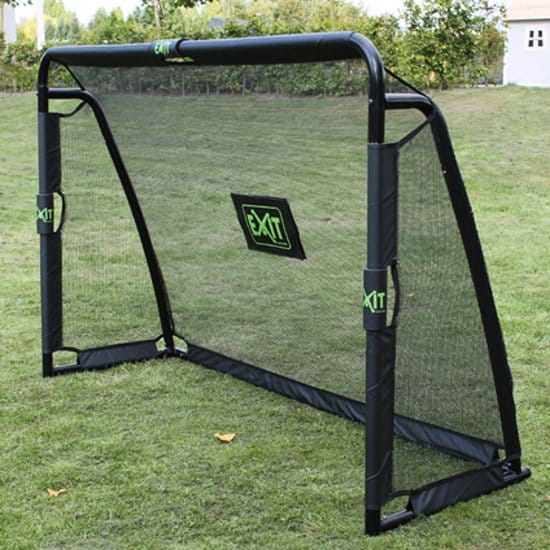
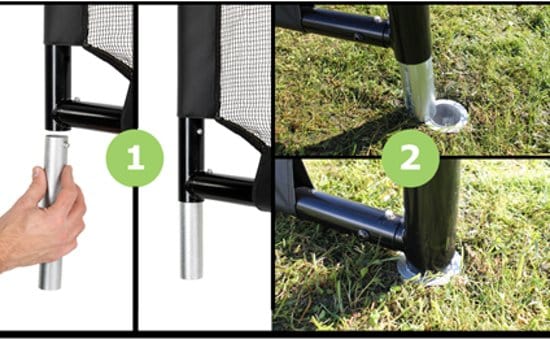
It's not too big, so it fits in most gardens, but what makes it even more fun is that it has a precision canvas that you can hang in front of it so that your kids who are playing football or want to go to football can practice their aiming well, too. At home.
Best Collapsible Football Goal: EXIT Coppa
Players who are 8 years old use a goal that is 2 meters high and 3.6 meters wide and they play on a field that is 30 meters wide and 50 meters long.
Here's how the Coppa is put together:
The EXIT Coppa Soccer Goal is a great choice for the 6' x 12' category. Weighing in at just 25lbs and supplied with a carry bag, this goal is easy to set up and transport.
All the pipes click into place meaning no tools are required to build it.
For the wider goal, the Coppa goal is a popular choice. It also comes with a carrying case and its reduced depth makes it ideal for areas with limited space.
This EXIT Coppa football goal is more like practicing for the real matches and is still easy to carry.
Check prices and availability here
Best aluminum football goal: EXIT Scala

The dimensions change again for 10-year-old footballers, and at this point they remain the same for three years.
Football players aged 10-13 can play with goals that are 2 meters high and 5.4 meters wide.
By age 13, the target size and fields are considered to be at an adult level and not change again.
The Scala takes a little more time to assemble and you will probably want to put it in a permanent place:
From the age of 13, the goal is 2.44 meters high and 7.32 meters wide.
Taking small goals to a small field is still a good option. But if you really want to practice shooting (and goalkeeping) you should look at the bigger targets, like this one from EXIT:
Don't be fooled by those way too small kids with a way too big a goal, your teens will have a blast with these.
Best Cheap Kids Soccer Goals: Dunlop Mini

The Dunlop mini goal is a compact goal tent that you can set up with one click. The frame is 90 x 59 x 61 cm and feels sturdy when you put it on the floor.
It also has four ground spikes to keep it firmly in place, so even when you go on an adventure, you can take your targets with you!
Set up your own little soccer game by simply snapping the net onto the sturdy base and it's just really cheap for the quality you get.
A nice goal that will last your child for a long time.
Why your own football goal for in the garden?
Football is extremely popular with young aspiring athletes, and it seems that if children don't start playing the sport at a very early age, they end up being left behind in their later development.
You develop a feeling for the ball from an early age and a large part of that is aiming and steering the ball (in the direction of a goal).
So if your child is getting started with “this beautiful game” from a young age, you could be faced with a dilemma about what the right soccer goal is for their skill level.
Football can be played with a goal of any size, but to practice with a goal that matches what they will be playing in their Saturday morning league games, there are specific soccer sizes that are made for players of different ages.
How do I know which soccer goal size is appropriate for my child's age and skill level?
Practice with goals before they go to football
For the really small children it is fun to kick a ball, occasionally pick it up and throw it and just run after it.
You can already see some really young children trying to give a certain direction to the stairs. Maybe this is talent!
These are children who might like to practice with a first practice goal before they even play football.
For example, for children who are so small, you can buy this electronic goal from Chicco, which makes noise with every goal.
From 4-6 are they mini pupils and they can frolic and practice a bit at the club.
How do I install a football goal?
Installing soccer goals is usually quite simple and easy, even in the case of permanent or semi-permanent soccer goals.
Sometimes, as in the case of portable or wheeled football goals, installation is as simple as carrying or pushing the goal onto the pitch!
But all targets require you to anchor, install, or weigh the target to keep it stable and upright during the game.
Installation must be done properly, otherwise your target could topple after a hard hit and risk injuring players or bystanders.
(Note: these are general installation suggestions. Always follow the installation instructions for each football goal)
Also read: these are the best goalkeeper gloves for match or just a game of soccer at home
soccer goal anchors
Anchor the goal to the grass or turf using plastic or metal anchors anchored in the ground, through the net or attached to the frame.
If anchors are not provided or goals are used on hard concrete or gym surfaces, secure the goal frame to the ground using weights or sandbags.
If necessary, place weights over the rear bar and sidebar frames.
Permanent or semi-permanent football goals
Install ground stakes in the grass or turf (ground sleeves must be included with your purchase) where the goal frames will be installed.
Which training target is right for me or my team?
Once you've got all your football gear, you'll want to get better. To hone your game and develop soccer skills, it's important to get out there and practice!
That's why we have some of the most versatile and diverse football training goals, rebounders and goals in the game today.
These training targets can be used at home in the backyard or on the field with your team.
It's all about finding the one that works for you, your skill level, your space and your budget.
rebounders: With the frame of a traditional soccer goal, but with a taught net designed to send the soccer ball back to you, players let the rebounders practice their shooting power, accuracy, placement and speed.
Football rebounders come in all shapes and sizes and are affordable enough for personal use or for team practice. Great for players of all ages and levels!
Training Goals: Extremely lightweight and portable, training targets are quick to set up and can go almost anywhere. They let you practice your shots and skills in the park, backyard or even on the sidelines during a match! Incredibly versatile, as well as affordable, training goals? Great for any player on the field.
Coaching Goals: a double-sided soccer goal, with a frame and a net design, Coaching goals let coaches perform multiple exercises and train the whole team at once! It also allows two goalkeepers to train at the same time. Designed for more advanced players and teams, Coaching goals are great for football clubs, schools and advanced league training.
Also read all about the right training gear for a football training
Exercises without a goal
Not every target practice requires a target. An easy-to-install exercise makes cones three to five meters apart.
Have two players face each other across the row of cones. They pass/shoot the ball between the cones, gradually moving further away from each other as accuracy improves.
If space is an issue, the distance between the cones can be gradually reduced. A few pawns like this set at Bol.com is ideal for a team training exercise.
Pass and shoot
Before young players are ready to make the jump to full goals, there are two options that work well; 6' x 18' and 7' by 21'.
If you like depth with your goal, then such an EXIT goal is the right choice for you. It is made with lightweight aluminum tubing and the push button construction makes it quick and easy to set up.
A fun practice with these target sizes is a simple pass and shoot routine. With one goal in front of a goalkeeper, players stand approximately 25 yards in front of the goal.
They pass the ball to a coach standing on the edge of the penalty area and rush forward to return, meeting the ball at the top of the box for a first shot.
How do I know which football net is suitable for my purpose?
If your football net is old, torn, damaged, tangled or obsolete, it is definitely time to replace it with a brand new football net!
But which one do you go with and how do you know if it's the right one for your purpose? After all, football nets all look the same!
This can certainly make your decision a bit difficult, but if you know what to look for, you will see what different football nets are really like, and you will find that it is quite easy for you to get the right one.
Look for these features when looking for a new football net:
- net size: Nets, like the target, come in standard sizes to conform to standard target frames. So pay attention to the size of your target for the correct net.
- Net depth: Some advanced football goals have depth, which allows more space in the goal. Replacement football nets must also have depth to fit these frames. Look for football nets with three or more dimensions (ie 8x 24x 6x6). The first two refer to the length and width of the net. The second two dimensions relate to the top depth and bottom base depth of the net.
- rope thickness: The durability, performance and price of a net has a lot to do with the thickness of the rope. Budget soccer nets usually have a 2mm thick rope, while more advanced, pro-level and expensive nets use a 3 or 3,5mm rope.
- Mesh Size: The density of the net fabric affects the performance and durability of the net. Most soccer nets are 120mm wide, while other soccer nets are tighter, at 3,5” (88,9mm) or ever a 5.5” (139,7mm) hex mesh.
- Grid accessories: Modern goals come with secure net attachment systems, such as clips and bars, that secure the net to the frame. It is important to purchase a target with these features, or add them to existing targets with separately purchased and installed clips. Velcro strips are also ideal for temporarily attaching nets to frame posts.
Once you have the right target in mind, you can start setting it up in your garden, nearby playing field, training field or football field and immediately start practicing shooting and passing. Everything that makes football such a fun sport!
You can do it wherever you have a ball, and now also a goal!
Also read: the best football shin guards


